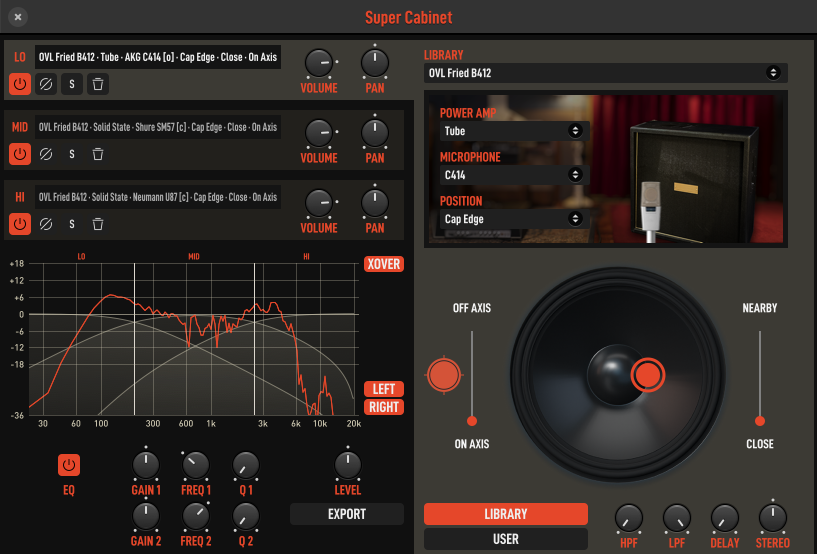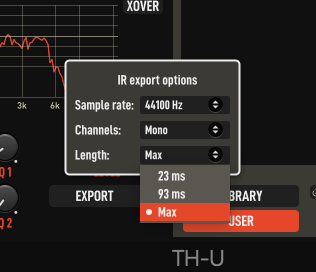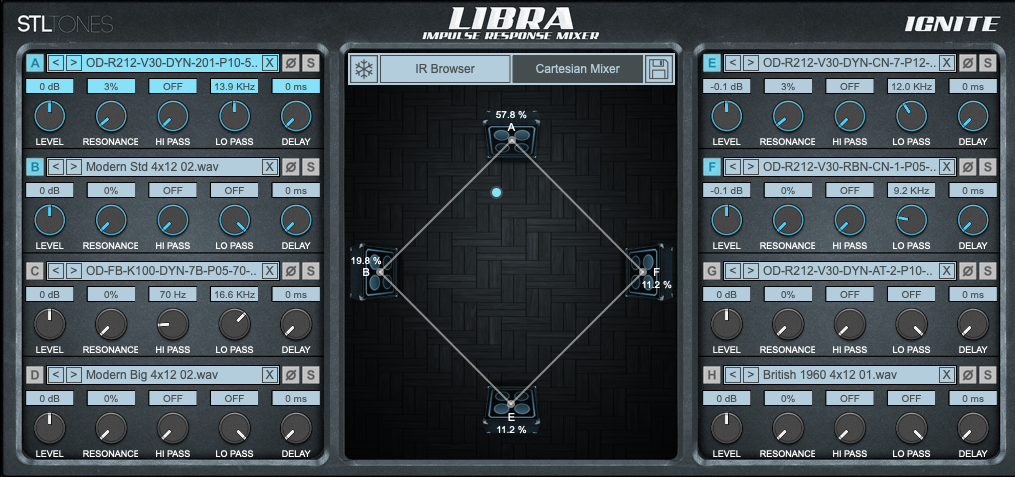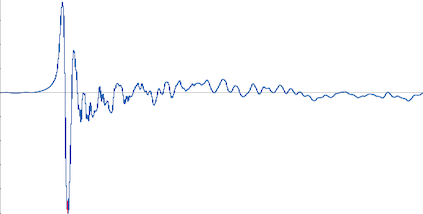Introduction
Updated May 1, 2022
If you are using a Mac or a PC for guitar practice and recording, chances are that you are using a DAW and some pedal/amp simulations. As presented in our IR part 2 blog post, one key piece of software you need is the IR loader : this one is responsible for combining your guitar and amp signal with the captured cab+mic signature and produce the final result.
While many amp simulators provide an embedded cab section -and more often than not, this section is able to load 3rd party/custom IRs-, this component is usually less flexible than dedicated IR loaders. For instance, using a separated and dedicated IR loader usually allows me to achieve the best tone and provides greater control and tone shaping options. This blog post presents an overview of the signal flow and the characteristics of popular free and paid options.
Embedded IR loaders in amp sims
Many amp sims embed an IR loader capability : it is the case for Overloud Thx, Mercuriall plugins (Reaxis for example), Positive grid Bias Amp, TSE X50, …. And some of them can be quite sophisticated by allowing you to select different IR positions. That is the case for example for Mercuriall Reaxis or Overloud TH3.


In these two amp sims, you can load standard third-party IRs but in that case you will loose the positioning capability.
Other amps sims have only « classical » IR loading capability, without mic placement (see TSEX50 below):

All these amp sims are able to achieve great results by using either the bundled IRs or 3rd party IRs.
However, if you want to achieve better tone control and have more options to tweak your sound, you can also turn off their cab/IR section and route your signal to a dedicated loader plugin.
Routing to a dedicated plugin
It is as simple as adding your IR loader plugin after your amp sim plugin AND to turn-off the cab section of your amp sim (or to remove the CAB block in TH3 for example). Else, piling-up 2 loaders will end-up with a muffled -unusable- tone….

In my personal situation, I use different setups when practicing or recording guitars (or trying to) :
- full digital, using pedal sims and amp sims plugins (using DI input)
- overdrive pedal then digital with amps sims
- overdrive and preamp pedal then digital (using power amp sims in this case)
- overdrive and amp, Torpedo Reload then digital
I am also using different IRs providers, mainly Two-Notes and Ownhammer, as well as my own IRs that you can download from the Resources / Impulse Responses Download page (here). I often change the overdrive and amps I am using, as well as I frequently tweak my settings against the same IR. To achieve consistent results, I am using dedicated IR loaders : mainly Nadir 2.0, Libra and Two-Notes Wall of Sound.
Software IR Loaders
Which loader to choose ? Should not I just drop one one of the free loaders and be set ? Should not all the loaders produce the same results ? Well, IR loaders should achieve the same results by using the very same IR. But you may find that loaders can behave a little bit differently as they may be applying some offset or not to your IR file, they may be using internal oversampling -or not-, they may have different calibration in volume handling (in and out) or they may have some limits when it comes to handling IR length. All these more or less subtle differences can lead to small or noticeable variations in the resulting sound.
Furthermore, features packed loaders will provide more weapons to tailor your tone, so spending some time choosing one or two may be worth it.
Let’s remember that IR volume has an important place in the result : using a separate plugin will allow you to adjust the volume, if needed, using a gain plugin, or raising the output volume of the amp sim section….
Free IR loaders
We will mention three completely free IR loaders :
- Nadir by Ignite Amps
- Pulse by Lancaster Audio (ex Rosen Digital Audio)
- Lepou (Poulin) LeCab2 (discontinued)
If there was only one of these that you should download and use, then get Nadir : it is a no non-sense, straightforward IR loader. It is created and maintained by IgniteAmps. The current version can be downloaded from STLTones : https://www.stltones.com/products/stl-ignite-emissary-plug-in-bundle as part of the Ignite Emissary bundle (create an account, put this plugin in your cart and then check out, it is free).
Nadir 2.0 has all the basic controls for IR loading and its UI is simple and straightforward. It can load two IRs at a time and you can mix them. Navigating IR collections is easy with the folder view that sits at the center of the UI and it offers some presets support capabilities. It supports 3 routing modes : MONO, DUAL MONO and STEREO and provides a HPF, a LPF and a resonance control (described in this blog post). You can adjust the in / out volumes of the plugin as well as each IR volume. Nadir gives great results. If there were input and output VU-METERs for volume monitoring it would be perfect, but you can still use metering plugins from your DAW before and after Nadir.
Two important items that I often use may be missing : no embedded power amp sims (see this blog post : IR Part 4) and no embedded EQ. Of course, you can still rely on other plugins for this.

Pulse, from Lancaster Audio is another completely free option. It is basically a stripped-down, simplified version of Nadir, with a handy A/B button to swap IRs when auditioning. Looks like it was built on the ground of Nadir 1.x and it does not have the resonance control. Gives great result as well. Download from : https://lancasteraudio.com/pulse/.

It seems that Lepou blog and plugins activity have ended : they were among the best free plugins available on the web with multiple amp sims and one IR loader (LeCab). You may still find some copies on the internet -but scan the files for safety if you download them from unknown or untrusted places-.
LeCab2 is an IR loader that goes straight to the point : it allows for loading and mixing 6 IRs with a useful phase switch, a delay for fine adjustment of phase, high pass, low pass, and volume controls. I do not use it much nowadays, primarily because it processes my custom IRs with a strange frequency shift. Works well with many IRs, though.

Paid options
I am listing 5 paid options here :
- Two-Notes Wall Of Sound
- Overloud SuperCabinet
- Libra by Ignite Amps
- RedWirez MixIR3
- 3 Sigma Audio Impulsive
Two-Notes Wall Of Sound (WOS) is my favorite IR loader : I am lucky to own multiple Two-Notes hardware and I discovered the WOS plugin with the Torpedo Reload (a load-box / DI / reamp box from Two-Notes). Wall Of Sound was free during the first French COVID-19 lockdown period (until May 11,2020). You can get a basic license (“Essentials”) with 8 cabs for 39 Euros. In short, I think WOS is one of the best loaders available out there. It supports Two-Notes CABs and conventional IRs and has everything under one roof : it is very efficient for tone shaping, be it for practice or recording. Volume metering in an out ? check. Mic placement (Two-Notes cab only) ? check. Power amp simulations ? check. Adjusting phase ? check. EQ’s ? check. Exciter ? check. Compressor ? check. Reverb ? check…. You can load and mix an unlimited number of up to 20 cabs or regular IRs, as long as your CPU -and your ears- can cope with them…. Excluding mic placement, all theses features can be used with conventional IRs. Excellent sound quality, almost bug free… Go for it ! https://www.two-notes.com/fr/wall-of-sound. Ha, and it comes with a complete and very good quality documentation.

Overloud is well known for its TH-U guitar amp simulator : it is probably one of the very best on the market today. In May this year (2021), Overloud upgraded its guitar cab sim capabilities with the release of SuperCabinet, which is available as a module of TH-U (Premium edition) or as a standalone plugin. SuperCabinet allows you to mix 4 Overloud cabs or 4 regular IRs in standard mixing mode, and 3 Cabs or IRs in multi-band mix mode. It comes with HPF, LPF, delay and 2 bands EQ and offers the capability to save the resulting IR (more infos in my SuperCabinet release post) : you can prepare and tweak your IR here and then use it on your multi-effects system, for example. 79 Euros, see https://www.overloud.com/products/supercabinet.


Libra is available from STL Tones : it is basically Nadir on steroids as it is able to load and mix up to 8 IRs with an intuitive and graphical “cartesian mixer”. It uses the same controls as the one described above in the Nadir section and provide great sound quality as well. It supports IRs with length up to 500 ms and can save your mix into a new IR. Requires an ILok free account. 49,99 $, see STL Tones : https://www.stltones.com/products/stl-ignite-libra-1

Redwirez is a well established name in the IR universe. It emerged as one of the early players and has earned a solid reputation in terms of IR quality. I do not own MixIR3 but it seems to provide a solid alternative to Two-Notes Wall Of Sound by offering MixIR3 modules where you can select speakers and adjust mic placement. MixIR3 comes with 3 processing modules : Redwirez REQ (eq and filters), a PCM60 reverb and a Giganator effect (live gig style EQ). Users can mix and process IRs within MixIR and export the resulting IRs. 59.99 $ , https://redwirez.com/products/mixir3-ir-loader

I do not own Impulsive from 3 Sigma Audio but I have been playing with the evaluation version of TSEX50 and Impulsive seems to be the loader module of TSEX50. A no non-sense loader and straight to the point : 2 IRs can be loaded and mixed, you can tweak the volume, revert phase, adjust IR delay, set a HPF and LPF, and apply some predefined EQ settings (« movement »). A simple and straight IR loader that comes with a set of IR files (3 cabs). I enjoy the frequency graphs of the IRs as they are interesting to check on IR’s low-end and the IR overall profile. 20.00 $. https://www.3sigmaaudio.com/impulsive/

Conclusion
Using a dedicated IR loader may provide you more tone control options and a better sound quality, especially if you use multiple gear configurations.
If you really want to compare the tone and quality of amp sims or real guitar gear, it is interesting to use a dedicated IR loader with IRs that you know well. This will be a stable and well-known component in your signal chain and you will be able to discover how much of the amp sims and presets tone are actually relying on IR tone.
Continue reading
Previous post : Impulse responses : part 6 (usage advices)
Next post : Impulse responses part 8 : using EQ
Change log
- Created May 10 2020
- Updated June 6 2021
- Updated January 10 2022 : added THU export screenshots and typos
- Updated May 1, 2022 : updated WOS pricing

Leave a Reply